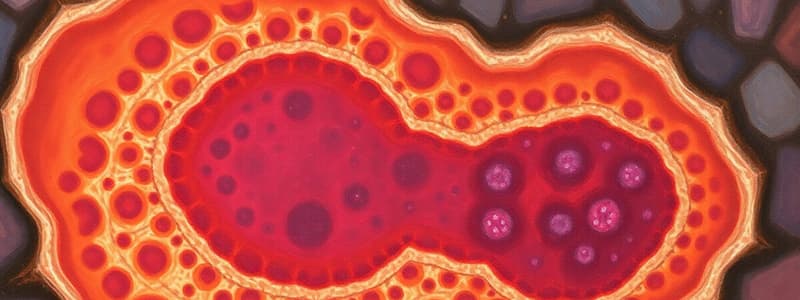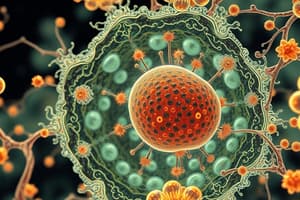Podcast
Questions and Answers
Which cellular component is responsible for the breakdown of waste and cellular debris?
Which cellular component is responsible for the breakdown of waste and cellular debris?
- Mitochondria
- Golgi apparatus
- Lysosomes (correct)
- Endoplasmic reticulum
What is the primary function of the plasma membrane?
What is the primary function of the plasma membrane?
- Storing genetic information
- Controlling the entry and exit of substances (correct)
- Synthesizing proteins
- Producing energy for the cell
Which process is essential for growth and tissue repair?
Which process is essential for growth and tissue repair?
- Mitosis (correct)
- Transcription
- Meiosis
- Fertilization
What is the difference between hyperplasia and hypertrophy?
What is the difference between hyperplasia and hypertrophy?
Which of the following is NOT a characteristic of dysplasia?
Which of the following is NOT a characteristic of dysplasia?
What is the primary function of the cytoskeleton?
What is the primary function of the cytoskeleton?
Which of the following is a characteristic of meiosis?
Which of the following is a characteristic of meiosis?
Which of the following is an example of cell atrophy?
Which of the following is an example of cell atrophy?
Flashcards
What is a cell?
What is a cell?
The basic unit of all living organisms, responsible for carrying out essential life processes. Its structure includes components like the plasma membrane, cytoplasm, nucleus, and organelles.
What's the plasma membrane?
What's the plasma membrane?
A selectively permeable barrier that regulates the passage of substances in and out of the cell. It maintains a stable internal environment.
What is the cytoplasm?
What is the cytoplasm?
The gel-like substance within the cell where essential metabolic reactions take place, such as protein synthesis and energy production.
What does the nucleus do?
What does the nucleus do?
Signup and view all the flashcards
What is the role of mitochondria?
What is the role of mitochondria?
Signup and view all the flashcards
What is mitosis?
What is mitosis?
Signup and view all the flashcards
What is meiosis?
What is meiosis?
Signup and view all the flashcards
What is neoplasia?
What is neoplasia?
Signup and view all the flashcards
Study Notes
Cytology Learning Outcomes
- Cells are the fundamental units of life, composed of various components
- Plasma membrane regulates substance entry/exit
- Cytoplasm is a gel-like substance where metabolic processes occur
- Nucleus contains DNA, controlling cellular functions
- Mitochondria are the powerhouses of the cell, producing ATP
- Endoplasmic reticulum (both rough and smooth) are involved in protein and lipid synthesis
- Golgi apparatus modifies, packages, and transports proteins
- Lysosomes digest waste and pathogens
- Centrosomes organize microtubules, vital for cell division
- Cytoskeleton provides structure, aiding transport and movement
Cell Structure and Function
- Plasma membrane encloses the cell, controlling transport
- Nucleus stores genetic material, directing cellular functions
- Mitochondria generate ATP, the cell's energy source
- Ribosomes synthesize proteins
- Golgi apparatus packages proteins for transport
- Lysosomes break down cellular waste and debris
- Cytoskeleton provides structural support and enables movement
Cell Division
- Mitosis produces two identical daughter cells, crucial for growth and repair
- Mitosis phases include interphase, prophase, metaphase, anaphase, telophase, and cytokinesis
- Meiosis creates four genetically diverse haploid cells, essential for sexual reproduction
- Meiosis is characterized by two rounds of division
Cell Growth Abnormalities
- Hyperplasia involves excessive cell growth
- Hypoplasia refers to underdevelopment or reduced cell number
- Atrophy is cell shrinkage due to disuse or disease
- Hypertrophy is an increase in cell size
- Dysplasia is abnormal cell growth, potentially precancerous
- Neoplasia involves uncontrolled cell growth, resulting in tumors (benign or malignant)
Cell Structure Diagram Summary
- Diagram shows the detailed internal components of a typical animal cell
- Labels like Rough ER, Smooth ER, Golgi, Mitochondria, Lysosomes, Nucleus & Ribosomes are shown.
- The membrane and cytoplasm are also key parts of the diagram
Active and Passive Transport
- Osmosis is water movement across a semi-permeable membrane from high to low concentration
- Active transport moves substances against a concentration gradient, using energy
- Passive transport moves substances down a concentration gradient, requiring no energy
Studying That Suits You
Use AI to generate personalized quizzes and flashcards to suit your learning preferences.
Related Documents
Description
Test your knowledge on the fundamental units of life with this quiz focused on cytology. Explore key components such as the plasma membrane, nucleus, mitochondria, and other essential organelles that contribute to cellular processes. Perfect for biology students looking to deepen their understanding of cell function.




